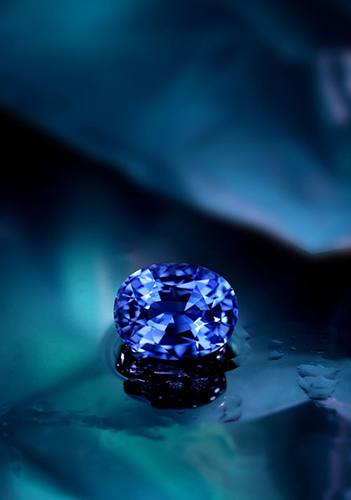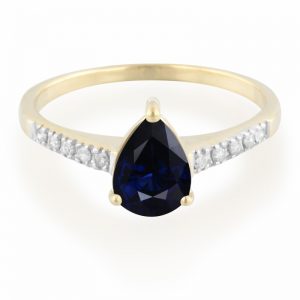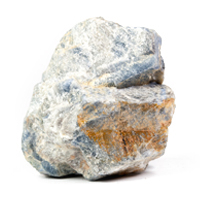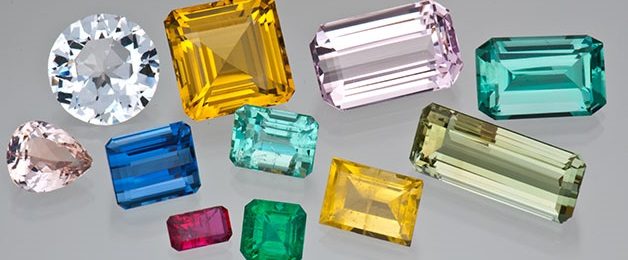Gemstones are unique gifts of nature. Some of them are real treasures – treasures that want to be found. This in turn encourages risky ventures in the most remote regions of the world in their hunt. Since sources are usually not easy to find, secrets, legends and miraculous stories are spun like a spider’s web about their existence. The Kashmir Sapphire is one of the exceptional stones with which facts and legends are closely interwoven.
Experts agree on one thing: this gemstone is the fairest among sapphires. The uniquely beautiful shade of blue, makes Kashmir Sapphire the king of sapphires. It is a true rarity. Owning such a noble and exclusive gem is the dream of collectors and gemstone lovers alike.

Sapphire from Rocks & Co.
Before our journey takes us into the Himalayas, let’s take a trip to the French Riviera. To be precise, the principality of Monaco, where a Kashmir Sapphire was auctioned a few years ago. Obtained from the SSEF (Swiss Gemological Society) the scheduled sale price was €150,000, the cut, 10.81 carat, certified Güblin Kashmir Sapphire sold at a fabulous auction price of €750,000. The buyer, a Swiss diamond dealer, who wishes to remain anonymous. The gem reached such a high price not only for the impeccable quality of the stone but also because of the rarity of Kashmir Sapphire.
The expert and gemologist Chantal Beauvoix confirmed: “Since the mine has been closed in Kashmir, one does not find stones of such quality, especially not in this colour quality.”
But is this source closed forever and completely exhausted?
Kashmir Sapphire deposits at over 4,000 meters
Kashmir is an area of tension between India and Pakistan. It is specifically in the Zanskar region in Indian Kashmir where the famous Sapphires were mined. The first Sapphires from Kashmir appeared on the gemstone market in 1881. The Highlanders exchanged them against salt in equal parts! Imagine, in these ancient times when a few pounds of salt were exchanged for the same weight of gems! The locals used this hard corundum to sharpen their tools. The considerable hardness of the mineral (9 on the Mohs scale) made it possible for them to carve and polish metal. In 1882 an association of jewellers bought a collection of Kashmir Sapphires worth $90,000. This prompted the Maharajah of Kashmir to put his hands on the mines, to prohibit the uncontrolled trade and to send his army to guard the deposits. The operation of the Kashmir Sapphire mines lasted until 1979 and then came to an abrupt stop. The mines were exhausted. However in recent years, there have been rumours of the reopening of the mines and from time to time a Kashmir Sapphire falls into the gem market like a welcome miracle!
Some deposits were reopened a few years ago. They are found in the mines of Padder at over 4000 meters hight, through the terrible Pass Umasi to 5300 meters. These deposits can only be worked on by miners for a few months each year. Snow in the mountains makes them impossible tasks in winter and minors are quickly exhausted by the physical work at these altitudes. Despite this, between 50 and 100 grams of Kashmir Sapphire is extracted each day. The most beautiful and precious Kashmir Sapphire specimens were found in the veins of kaolinite (white aluminum silicate). The precious stones are then transported by the police or army into the city of Kichtwar. These quantities are tiny on the scale of the planet, the amounts found are negligible – making it obviously one of the rarest gemstones in the world!
When the heart of a gem hunter beats in your chest, you might want to try to explore the remaining deposits. It appears that dozens of mines and deposits in these mountains, abandoned and undeveloped, are still teeming with these extraordinary gems! Maybe I should still plan my next vacation there ….

Rocks & Co. offers an incredible selection of blue sapphire jewellery
An incredible colour
The fame of the Kashmir Sapphire is owed to its unparalleled colour which makes it so rare and desirable. The blue has a silky quality and is intensely luminous with hints of violet. One finds some genuine specimens at stone markets in India and Pakistan, but beware! Many sapphires are sold as being Kashmir Sapphires for a considerable price, but are in fact Burmese Sapphires. Burmese Sapphires are treated with an iron and titanium diffusion at 1700°C to stain the surface. A quick trick used by experts is to dip the sapphire in glycerine, if dark blue contours appear around the stone this indicates it has been diffused.
Therefore we would like to take this opportunity to reiterate: the authenticity and true origins of a gemstone should always be certified by reputable companies and provided with a guarantee of its authenticity!
Gemological expertise: highly specialized

A sapphire in its kaolinite matrix.
Experts can authenticate a Kashmir Sapphire from its inclusions. For gemological enthusiasts I want to share the following information: the Kashmir sapphire has inclusions of Dravit (black brown tourmaline), Pargasit (found only in Kashmir Sapphires or Rubies from Myanmar and Tanzania), Zircon, Allanit (these crystals are very rare and only found in Kashmir Sapphires), biotite, Garnet, uranium oxide and uraninite. Also, “milky” bands of rutile inclusions and fine white particles, called “snowflakes”, can be observed in the Kashmir Sapphire.
Kashmir Sapphire – stone of immortality
But enough of the technicalities. Kashmir Sapphire is charged with deep rooted symbolism. In India it is the “stone of immortality”. The Persians believed the universe is lying on a sea of sapphires. In fact, this gemstone seems truly immortal. Although its physical occurrence seems almost exhausted, when one dives deep into its myths it is reborn again and will amaze all lovers of precious stones for many years. Kashmir Sapphire draws us into her spell and will not let us go!
Gemstone ‘hunter’ & expert Don Kogen recently acquired a single Kashmir Sapphire with which Kat Florence designed an incredible piece, especially for him!

Incredible Kashmir Sapphire ring designed by Kat Florence
Discover stunning Sapphire Jewellery below cost price in our online shop >






